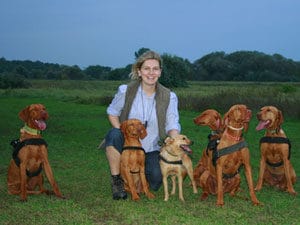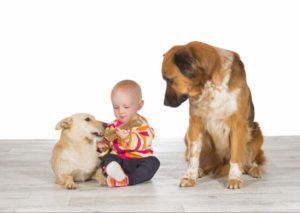
By Jon Bastian
One of Cesar’s core principals of dog psychology is that they are pack animals and the pack has a hierarchy of leaders and followers. Cesar came to this conclusion over years of working with packs of dogs and observing their behavior. However, critics of Cesar’s methods say that this theory of dog behavior is outdated and based on captive wolves.
Science is catching up to Cesar, though, and a recent study done by researchers from Oxford University, Eötvös University, Budapest and the Hungarian Academy of Sciences (HAS) shows that a pack of dogs does, in fact, have its own social hierarchy, with leaders and followers.
The study was carried out using very sensitive high-resolution GPS tracking devices on a pack of six vizslas, a good-natured and very trainable Hungarian breed of hunting dog. There were six dogs involved, and they were tracked over the course of fourteen off-leash walks of about thirty to forty minutes each.
“We showed that it is possible to determine the social ranking and personality traits of each dog from their GPS movement data,” said study author Dr. Máté Nagy. “On individual walks it is hard to identify one permanent leader, but over longer timescales it soon becomes clear that some dogs are followed by peers more often than others. Overall, the collective motion of the pack is strongly influenced by an underlying social network.”
According to a press release from Oxford University, “The study, published in PLOS Computational Biology, demonstrates the power of path tracking to measure social behavior and automatically determine dogs’ personalities. In the future, one possible use of the technology would be to assess search and rescue dogs to see which dogs work best together.”
Conclusions

One of the conclusions of the study is something that Cesar’s fans will find very familiar: “Dogs that led more often had higher dominance ranks in everyday situations, assessed by a dominance questionnaire… Pack leadership is well-established in wolves, where packs are typically led by a single breeding pair, but there is still much debate as to whether groups of domestic dogs have a social hierarchy.”
This study may be the first hard evidence that this social hierarchy does exist. According to Dr. Enikő Kubinyi, senior author of the study from the Hungarian Academy of Sciences, “On average, an individual took the role of the leader in a given pair in about three quarters of the time. This ratio is of similar magnitude to the case of wild wolf packs with several breeding individuals. Using this qualitative data over longer time scales allows us to see the more subtle relationships that might otherwise be missed.”
The study is part of the European Research Council project to study collective motion across a wide variety of organisms in nature. Called COLLMOT, it is led by Professor Tamás Vicsek of Eötvös University and HAS.
Is one dog in your pack clearly the leader of the others? Share your story in the comments!










